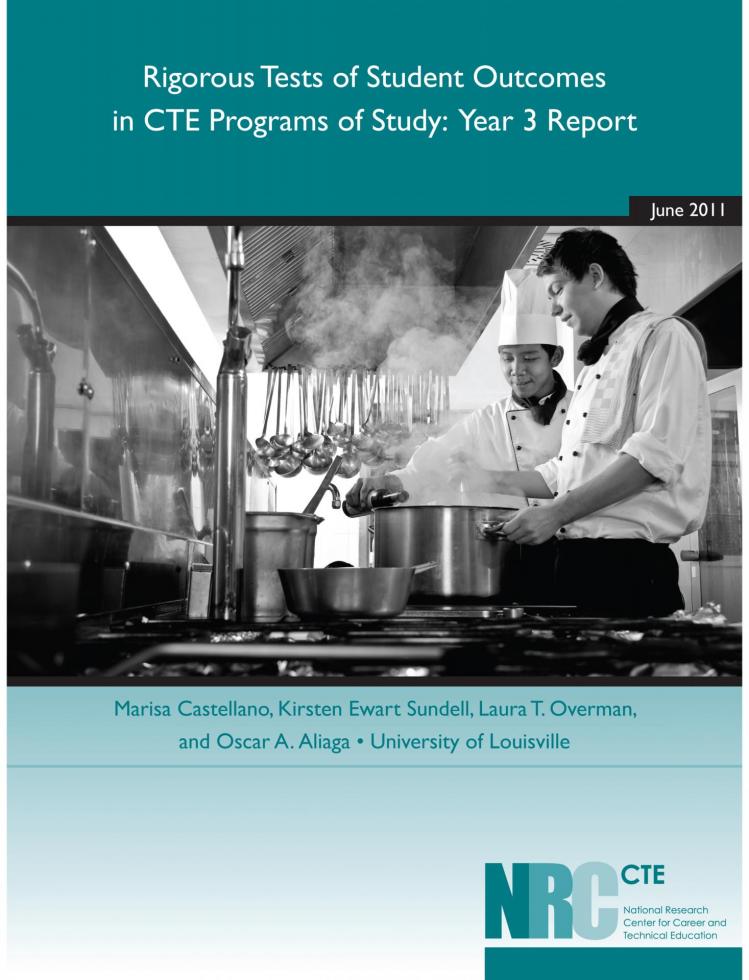Rigorous Tests of Student Outcomes in CTE Programs of Study: Year 3 Report
 This longitudinal study, currently
in its fourth year, is being conducted in the context of the
reauthorization of the Carl D. Perkins legislation (2006), which
funds career and technical education (CTE) nationwide. The recent
reauthorization, known as Perkins IV, modified existing practice
by increasing program accountability in the areas of academic
achievement, technical skills achievement, and alignment with
postsecondary technical education in the form of programs of
study (POS). The legislation also upheld previous emphases on
serving nontraditional students and those from special
populations (e.g., special education students). The Perkins
mandate sets a high standard, but many states and local education
agencies had already begun to develop programs to achieve these
goals. This study evaluates the impact of this federally mandated
education reform.
This longitudinal study, currently
in its fourth year, is being conducted in the context of the
reauthorization of the Carl D. Perkins legislation (2006), which
funds career and technical education (CTE) nationwide. The recent
reauthorization, known as Perkins IV, modified existing practice
by increasing program accountability in the areas of academic
achievement, technical skills achievement, and alignment with
postsecondary technical education in the form of programs of
study (POS). The legislation also upheld previous emphases on
serving nontraditional students and those from special
populations (e.g., special education students). The Perkins
mandate sets a high standard, but many states and local education
agencies had already begun to develop programs to achieve these
goals. This study evaluates the impact of this federally mandated
education reform.
The study also addresses several of the research strands identified by the United States Department of Education (USDE), Office of Vocational and Adult Education (OVAE) as integral to the agenda of the National Research Center for Career and Technical Education (NRCCTE). First, this scientifically based study in schools implementing CTE POS seeks to identify successful methods for addressing the education and training needs of high school students, including nontraditional and special populations. We are examining the effects of POS on student outcomes compared to the traditional high school experience (i.e., “business as usual”). Second, the results of this study may be used to increase the effectiveness and improve the implementation of POS at other high schools so that they implement coherent and rigorous CTE content aligned with challenging academic standards. The study is generating important results toward this end: longitudinal student outcome information on programs of study, including academic, technical, and work readiness measures.
POS are one way to address students’ need for relevance while also providing necessary rigor in academic and technical curricula. According to the Perkins IV legislation, POS should (a) consist of rigorous academic and technical content, (b) align to postsecondary programs without duplication, © include the opportunity for postsecondary credits to be earned in high school, and (d) lead to industry-recognized credentials at the postsecondary level. States are currently developing POS in many CTE program areas.
We have used the NRCCTE’s conceptual base of student engagement,
achievement, and transition to form research questions, develop
instruments and measures, and judge the effectiveness of the
participating POS. Student engagement is evident from students’
attendance and whether or not they stay in school—measures that
are included in this study.
We also focus on student achievement by investigating whether
POS, which integrate coherent and rigorous technical content with
challenging state academic standards, result in improvements in
the academic achievement of students. The experimental strand of
this study investigates the effects of POS on academic and
technical outcomes compared to control groups, which have been
made up of students who applied to be in the POS but were not
selected in a random assignment process. We are applying the same
research questions for the quasi-experimental strand of the
study, comparing outcomes in our treatment group to a
well-matched comparison group. The results of this study will
make an important contribution to the establishment of the
efficacy of CTE programs of study.
In addition to examining high school engagement and achievement
measures, this study also seeks to investigate the transition of
POS students to post-program employment or postsecondary
education. Our student cohort, at the time of this writing in the
11th grade, are on the cusp of making this transition at the
conclusion of our four-year longitudinal study. Should funding
permit, we will seek to extend the study and report on the
numbers of POS students who continue their education at the
articulating community college, including their first-year
coursework. In addition, we anticipate that some students will
transition directly to the workplace. Should an extension of the
study be funded, we would report on those outcomes, especially
job placement, wages, and retention after six or nine months.
Other important contributions that this study can make are in the
areas of nontraditional and special populations enrollments.
Perkins IV maintained the requirement that states measure student
participation in and completion of CTE programs by (a)
nontraditional students for that occupation and (b) special
population status. We will also report on the enrollment and
completion of special populations (i.e., students with
disabilities, special education students, economically
disadvantaged students, and/or students with limited English
proficiency) in these programs. We will address whether POS,
based on challenging academic standards and industry-recognized
technical standards, influence participation from such
populations.
Castellano, M., Sundell, K. E., Overman, L. T., & Aliaga, O. A. (2011, June). Rigorous tests of student outcomes in CTE programs of study: Year 3 report. Louisville, KY: National Research Center for Career and Technical Education, University of Louisville.

